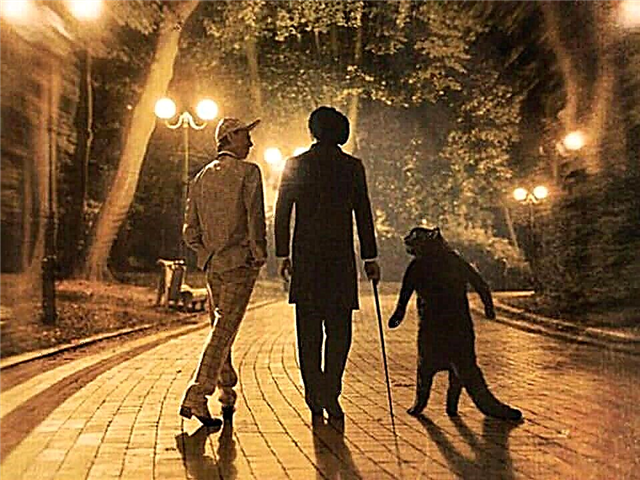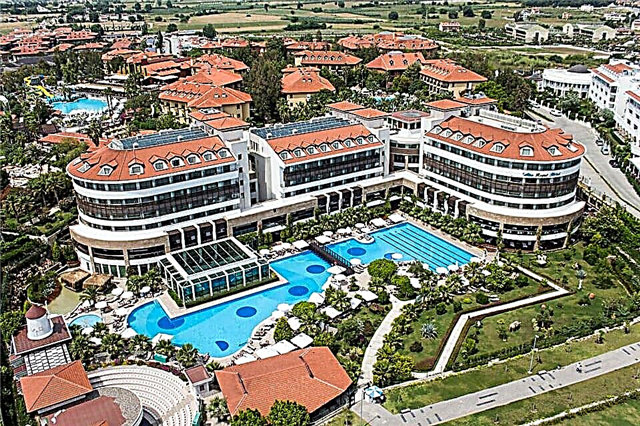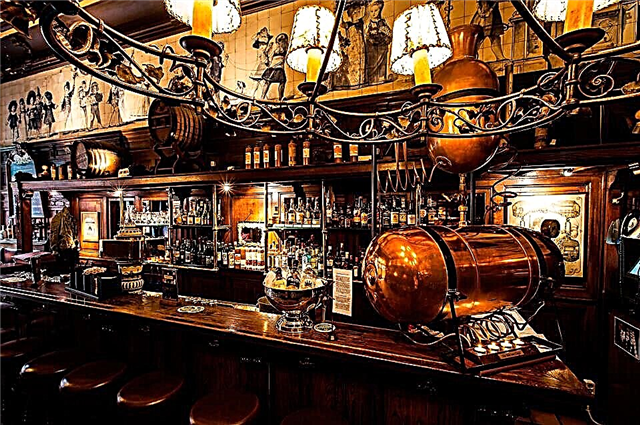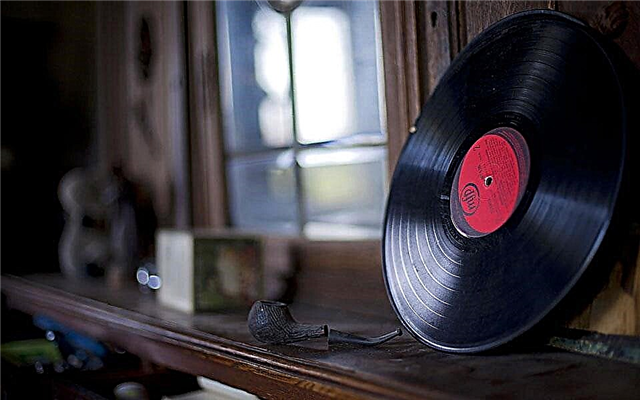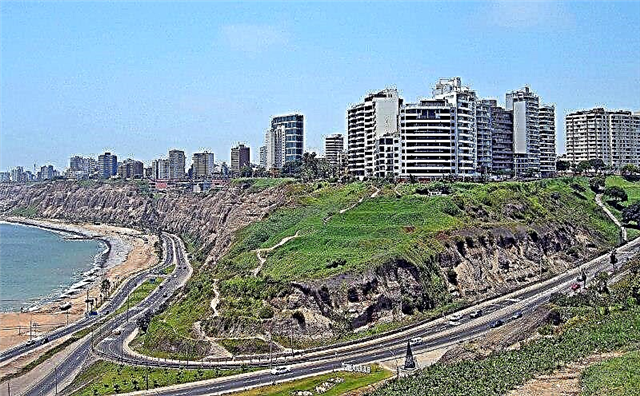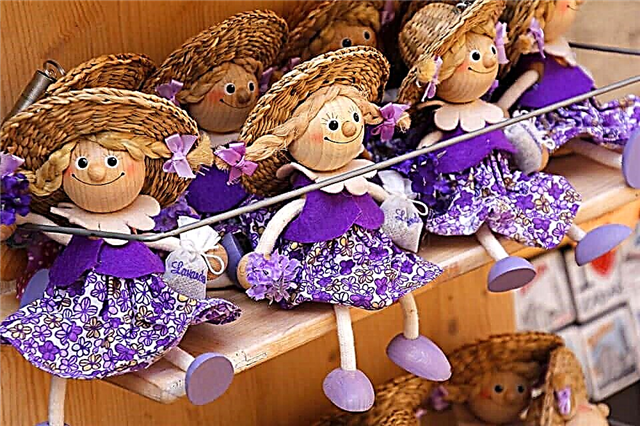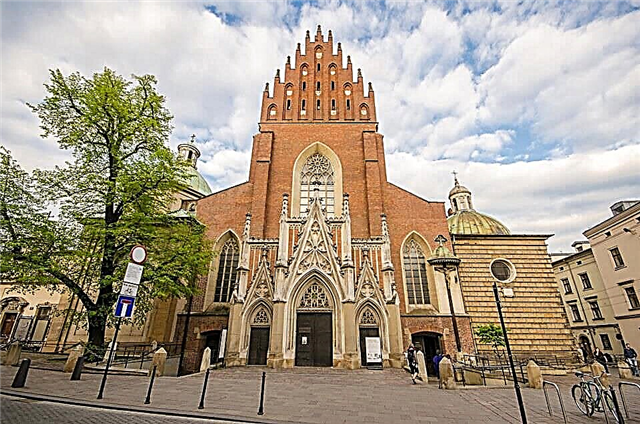According to one of the legends, Krakow is named after the prince Krak, who founded this city in the 10th century. At the beginning of the 11th century, the small city, having received the status of the capital of the state, began to rapidly develop and expand, turning into the main residence of the Polish kings. During its existence, Krakow has more than once experienced major political and military uprisings, but managed to preserve its "face" as a cultural and scientific center. There are many ancient monuments, cathedrals, which are real works of architecture in different directions.
St. Mary's Church (Church of the Assumption of the Blessed Virgin Mary)

This unusually beautiful building is located on the Market Square, serving as its main architectural decoration, which embodied three styles: magnificent Baroque, graceful Renaissance and strict Gothic. Otherwise, it is called the Church of the Assumption of the Blessed Virgin Mary. The central facade of the church opens onto the square with two quadrangular towers of different heights, crowned on the upper platform with short turrets and a long spire in the center. The high (82 m.) Square tower, rising upward, turns into an octagon due to 8 short turrets, the openwork of thin graceful spiers directed upwards. The second, lower tower serves as the bell tower of the cathedral. It contains a Renaissance-style chapel, outside the window of which there is a bell ringing for the dead. Its top in the corners is crowned with 5 domes: 4 small in the corners and one large in the center, crowned with low spiers.
The interior interiors dazzle with their luxurious beauty and rich splendor of the decoration of the altar and vaults. The Gothic carved wooden altar is unique among others of its kind for the size of its gates, decorated with huge figures of saints. The entire altar is painted with scenes from the Holy Scriptures, decorated with rich sparkling gilding, has a side-altar with the image of the genealogical tree of Christ.
Wawel castle

The ancient castle in Wawel for the Poles can be compared in importance with the significance of the Moscow Kremlin for the Russians. For many years Wawel was the political and administrative center of the state until the capital was moved to Warsaw. The royal castle, the cathedral, a number of defensive fortifications located on the banks of the Vistula are part of the Wawel castle complex. Now it is essentially a museum, where excursions are organized for those wishing to get acquainted with the historical past of Poland.
At the entrance to the castle, everyone is greeted by the sculptural monument of Tadeusz Kosciuszki, depicted sitting on a mighty horse. Everyone enters the main royal court through the Coat of Arms, to the right of which is the Cathedral with the mammoth bones hanging over the door - a symbol of prosperity; on the left - the Cathedral Museum. On the territory of the courtyard there are thematic exhibitions introducing the royal rooms, luxurious chambers, the art of the East; here is the treasure store, the Armory. Through the main courtyard you can go to the Dragon Cave.
In the Cathedral, Polish rulers were crowned and buried here. The current building, built in the 14th century, is a striking example of the Gothic style with characteristic pointed spiers, square columns and an abundance of long windows. There are chapels in which the remains of the Sigismund kings are buried, and the rotunda of the Blessed Virgin Mary is located here. Wawel Castle is a whole city that embodies the history of the Middle Ages of the Polish state.
Bishops palace

This strictly majestic, light yellow building is associated with the life of one of the most noble and kind-hearted Roman popes - John Paul II (Karol Wojtyła), who settled there in 1944, as a student of the seminary at the Archdiocese of Krakow. He left it with the rank of archbishop in 1978, when he was elected Pope. The Poles sacredly honor this palace as a memory of their wonderful compatriot: after his death for more than a month, the square in front of the palace was filled with flowers, candles and people praying.
The entrance to the palace is unusually beautiful, where, surrounded by picturesque shrubs and flowers, there is a monument to John Paul II with blessing hands raised to the flock. There is a symbolic window above the front door, from which the pontiff greeted the young people who came to meet him. Now inside the palace there is a museum of the pope's heritage, the expositions of which represent collections of gifts presented to him by the heads of state of the whole world; objects of ancient painting and sculpture. The Palace of Bishops is never empty during the day, there are always people who have come to pay tribute to the memory of a wonderful person and a religious figure with a pure and kind soul.
Market Square

Want to see the birthplace of Polish trade? Then go to the market square as soon as possible. This is a huge territory, which in the 13th century was set aside for business negotiations and trade. It is considered that the square is included in the list of the largest markets in Europe.In addition to the opportunity to plunge into local traditions and learn interesting facts from the history of the city, tourists can see famous sights, including the Town Hall tower, St. and some others.
The buildings surrounding the market deserve the utmost attention. Many of them were created during the Renaissance and Renaissance periods, are distinguished by strict forms and are a real decoration of the square. At the end of the walk, do not deny yourself the pleasure of purchasing the souvenirs sold here. The entrance to the square is free, it works around the clock. It is best to visit during the daytime when local attractions are open. The market is located at Stare Miasto, Rynek Glowny. You can get there by trams and buses, as well as on foot.
Market Dungeons

A local history museum is located under the Market Square. This unique institution reflects the history of the medieval city. The exhibition opened in 2010 after six years of archaeological excavations. As a result of research, ancient fragments of houses, structures, monuments, sidewalks and a market were discovered. The museum, located at a depth of four meters, is an amazing maze of a medieval street. Here you can see ancient walls, coins, vases, trade carts. Among the exhibits, there are multimedia displays equipped with touch screens with holograms. Modern technical equipment recreates the atmosphere of an archaic settlement.
Kazimierz

Surprisingly, Kazimierz is a city within a city. This is the part that has historically been occupied by representatives of the Jewish community. Therefore, it shouldn't come as a surprise that Jewish synagogues in this part of the former capital of Poland prevail over Catholic churches. All lovers of Jewish history should definitely visit this place, which is filled with Jewish cemeteries, objects of Jewish culture and religious sites. By the way, this very place was chosen by the authors of the film about the Holocaust "Schindler's List" as a film set.
If you find yourself in Kazimierz, we advise you to pay special attention to the two main attractions of the center of Jewish culture - the Church of St. Catherine and the Cathedral of the Corpus Christi. The first will charm you with the sound of a huge organ, which no other musical instrument can match. Well, in the second temple, tourists will have the opportunity to personally see the famous painting "Adoration of the Magi". You can find the Jewish quarter at Szeroka 24. As you can imagine, the entrance to the center of Jewish culture is free.You can get to the sight by trams that run along Starovishlna Street.
Aquapark

Love breathtaking water park rides and their amazing atmosphere? Then we invite you to visit one of the largest and most famous complexes in Eastern Europe! Guests can enjoy the huge water slides, swim in the clear water pools, relax in the jacuzzi and just have fun with friends or family. The main pride of the water park is a 202-meter slide, which will give visitors a three-minute descent along dizzying turns with a fall into a pool of warm water. There are simply no analogues to this attraction in Europe. All rides are divided into four groups and differ in color.
Some will provide inexpressible emotions with a downhill, others will add adrenaline to the blood with the help of all sorts of effects, and others will suit young vacationers. Of course, such a landmark cannot go unnoticed. Therefore, it is always crowded here: along with tourists, Poles ride the slides, who come to the water park from all over the country. The amusement park is open all year round. Tourists can buy a full-day pass, which will cost about 15 euros. Children under 3 years old are admitted free. You can find the water park at Dobrego Pasterza, 126. You can get there by buses, getting off at the Park Wodny stop.
Planty Park

But for those who are tired of the bustle of the city and visiting attractions, the best place to take a break will be the park ring - Planty. Poles like to spend their free time here. Young people hide in dense green thickets in search of solitude and romance, older people breathe free air or play chess, and tourists take pictures with pleasure against the backdrop of magnificent plants. But even here you will not be able to hide from the sights that are found at every step. Here you can find amazing sculptures, monuments, historical and cultural buildings, and even an archeology museum.
By the way, in his collection there are many exhibits of the history of Ancient Egypt, the period of the Middle Ages. To find Planty, it is enough to be in the area of the Old Town. This park ring surrounds its entire territory. According to historical information, this place was previously occupied by huge stone walls, which were designed to protect the inhabitants from uprisings and wars. The entrance to the park is free, but for visiting certain attractions on its territory, you will have to pay a small amount. You can visit the park at any time of the day (although not long ago tourists were forbidden to be here in the evening).
Florian's Gate and Barbican

It is recommended to visit these two attractions within the same excursion. Florian's Gate is located in the city's ramparts and was built in 1307. They owe their name to the patron saint of Krakow. A special feature of the gate is that the chapel of the Mother of God is located in it, and the coat of arms with an eagle and a relief depicting St. Florian are used as decorations.
The Barbican is also located here, which is a fortification in the form of a massive tower. There is a historical museum and on certain days real knightly competitions are held. Find attractions at ul. Basztowa, 30-547. They work daily from 10.30 am to 6 pm. You can get there by trams or buses, the route of which runs through the area. The cost of a ticket for adult visitors is PLN 7, and for beneficiaries and children - PLN 2 cheaper.
Cathedral of Saints Stanislav and Wenceslas

The Cathedral of Saints Stanislaus and Wenceslas is one of the most revered churches in Poland. The Basilica rises on the Wawel Hill among a monumental and luxurious architectural ensemble. The residence of the kings of the Polish-Lithuanian Commonwealth was located here, so the cathedral occupies a sacred place in Polish history. From time immemorial, the basilica was intended for the solemn coronation of monarchs, conducting divine services, and also served as a burial vault for rulers, bishops, politicians and military leaders.
The cathedral was erected at the turn of the XI-XII centuries. The original church building was a small Romanesque white limestone basilica. In the XIV century, the temple was rebuilt, thus the cathedral was expanded with three naves, chapels and towers. Numerous renovations of the church have significantly changed its appearance. Today the cathedral reflects an amazing jumble of different architectural styles - from Romanesque to Art Nouveau.
Chapels, treasuries and a church are located along the perimeter of the quadrangular brick basilica with elongated window openings.
The façade is majestically decorated with three towers, a triangular pediment, relief ornaments and sculptures of Saints Stanislav and Wenceslas. On the north side of the temple stands the Sigismund Tower. It has a massive cathedral bell weighing 11 tons. In the halls of the cathedral, separated by high arched openings, there are luxuriously decorated altars and royal stone, marble sarcophagi.
The relics of the patron saint of Poland - Bishop Stanislav are buried here. His remains are preserved in a silver tomb, which is a masterpiece of jewelry art. The sarcophagus is decorated with twelve relief images of scenes from the life of the saint. The cathedral's main altar, erected in 1650, is a large painting of Jesus crucified on the cross. The panel is framed with a gilded arch, pilasters and a pediment in the center.
Town hall tower

The central square is dominated by a gothic building made of red brick and creamy stone. This is the town hall tower, which was erected at the beginning of the XIV century. The building was part of a municipal building that was demolished due to dilapidation in the 19th century. The austere facade of the tower, whose height is 70 meters, is decorated with lancet and square windows, a mechanical clock, and is also framed by protruding vertical ribs. Over the entire history of its existence, the building has undergone several reconstructions after fires caused by lightning strikes. The tower is crowned with a baroque dome mounted on a polyhedron with arched window openings. A raging strong wind in 1703 pushed the structure 55 centimeters to the side.
The tower's narrow and spiral staircase leads to the observation deck, which offers a breathtaking panoramic view of the city. Inside the building are museum pieces related to the history of the municipality. Noteworthy are the basements of the tower, which were originally intended for storing beer and wine. Later, there were dungeons with torture chambers. Today, the underground of the building attracts visitors with aromatic coffee prepared in the cafe.
Collegium Mayus

More than 100 thousand students live in the city. Most of them study at the Jagiellonian University, which is considered one of the oldest in Europe. The celebrated college graduate is the astronomer Nicolaus Copernicus. The main historical building of the institution is called the Collegium Mayus (Great College).
The three-story Gothic structure with two stepped pediments, a small octagonal ledge and rectangular windows was erected in red brick in the 15th century. The walls of the college form a quadrangular courtyard surrounded by an arched gallery with a vaulted ceiling and massive white stone columns. There is a well in the center of the courtyard.
The beginning of the 20th century was marked by the transformation of the Collegium Mayus into a museum. Here you can visit the private chambers of professors, lecture and ceremonial halls, the dining room. The premises display original wooden furniture, unique scientific instruments, astronomical instruments, and a collection of globes.Painted portraits of professors who taught for 600 years are hung on the walls of the large hall of the university.
Ghetto Heroes Square

Among the many attractions, there is one place that reflects sad events in Polish history. This is the Ghetto Heroes' Square. The memorial cast-iron and bronze chairs standing on the paving stones stand out here. They symbolize the tragedy of the Jews of Krakow, imprisoned in the ghetto by the German occupiers during the Second World War. The Ghetto Heroes' Square is located on the site where in 1941 the Nazis drove all the Jews of the city beyond the fence. More than 20,000 people lived on this territory with their belongings and furniture in inhuman conditions. From here, the inhabitants of the ghetto were transported to Auschwitz.
Modern Art Museum

In 2004, the municipality bought out Schindler's former factory building to create a contemporary art museum there. Several years after reconstruction, the plant's pavilions were transformed into an avant-garde structure with a glass façade and gabled roofs.
Divided into several thematic zones. The spacious halls display interesting works that embody the urgent problems of society. These are exhibitions of conceptual art, collections of paintings by contemporary artists, sculptural compositions, photographs and performances with audiovisual accompaniment. Several cinemas show short films that make visitors think about being.
Polish Aviation Museum

On the territory of one of the oldest military airfield in Europe, in the suburbs of Krakow, there is a museum of Polish aviation. Here are real planes, helicopters, gliders and engines. There are more than 200 units of aviation equipment from different eras of both civil and military types. The models are housed in four buildings in a rotating propeller building and on the former airport runway. The premises include a cinema hall, a library, a flight simulator simulating a cockpit, information stands and interactive displays. Particularly impressive is the alley where Soviet MiG fighters are stationed.
Juliusz Slowacki Theater

Above the Square of the Holy Spirit dominates the magnificent palace, erected in 1893. It is one of the most famous theaters in Europe, named after the outstanding Polish poet and playwright Juliusz Slowacki. The building is considered a masterpiece of eclectic architecture, embodying the layering of different styles. The sandy facade of the building is decorated with numerous bas-reliefs, a portico with pilasters, balustrades, sculptures, massive vaulted windows and cornices.
The structure is crowned with baroque domes. Architectural decorations add sophistication and pomp to the building. The interior of the palace is no less impressive than the exterior. The halls are painted with frescoes by Austrian artists. The theater has four stages on which modern and classical dramas, operas, musicals and comedies are staged.
Church of Saints Peter and Paul

The Basilica of Saints Peter and Paul, illuminated in 1635, is the first baroque church in Poland. The church, built of dolomite and bricks, is surrounded by a wrought-iron fence, in front of which 12 statues of the apostles rise on pedestals. The three-tiered facade of the temple is decorated with pilasters with ornate capitals, pediments, bas-reliefs, niches with statues. The building of the basilica is single-nave with attached chapels and a semicircular apse. The structure is crowned with an elegant large dome.
The interior of the church is rather modest and monumental. In the main hall, which is framed by an arched arcade, there are carved benches for parishioners. The vault of the apse is decorated with bas-relief images describing scenes of the life and death of the apostles Peter and Paul. Noteworthy is the main altar, which is a marble pedestal with gilded sculptures. In the center there is a picturesque panel "Handing the keys to St. Peter". In the chapels, you can see many paintings and sculptures created according to all the canons of the Roman Catholic Church.
Basilica of the Holy Trinity

Not far from the Market Square stands an example of Gothic architecture - the Basilica of the Holy Trinity. The temple was erected in the middle of the 13th century under the leadership of the Catholic missionary Jacek Odrow. The church is a stronghold of tonsured monks who devote their lives to serving God. The basilica has three naves. There are ten chapels in them. The brick facade of the building is decorated with lancet windows with ornate bars. The temple is crowned with a large stepped pediment with Gothic turrets. The entrance to the basilica is through an extension. It is decorated with three graceful arches and gables decorated with bas-reliefs.
The interior of the church is striking in its wealth. Arches on tall columns stretch along the main nave. The walls are painted with colorful floral ornaments, and the ceiling is in the form of a cruciform vault. In the halls of the basilica, you can see many wooden statues, sculptures, frescoes and beautiful stained glass windows.
Sanctuary of Divine Mercy

The original religious building is located in the Lagiewniki district. This striking piece of modern architecture is called the Sanctuary of Divine Mercy. The basilica, built in 2002, does not give the impression of a traditional temple. On a large well-groomed area, a building rises in the form of an elongated ellipse, resembling an ark in shape. The modern façade of the shrine consists of glazed aluminum panels of various widths. The color of the interior of the temple is saturated with light shades. The walls and columns are made of raw concrete. The ceiling is decorated with radial beams.
In front of the church there is an oval tower, which is 77 meters high. It houses an observation deck with a truncated glass roof. The church is a place of pilgrimage for Catholics from all over the world. The sacred complex includes several chapels and large halls for worship. The main altar is made of a white marble block, the surface of which is like a tablecloth. Nearby there is a sculptural statue of a bare bush. There is a painting "Jesus, I trust you" is placed between the branches.
Kurgan Kosciuszko

Not far from Old Krakow there is a memorial mound dedicated to the national Polish hero Tadeusz Kosciuszko. This artificial mountain was built in 1823. The hill rises 34 meters. It consists of soils brought from the Polish and American fields where Kosciuszko fought. From the top of the embankment, you can admire the panorama of the city. The mound is framed by a brick fort built by the Austrians in the middle of the 19th century. The hill was a strategically important object in the defensive system of the fortress. On the territory of the fort, a wax museum is organized and an exhibition of memorabilia related to Kosciuszko is held.
Cloth rows

On the market square there is one of the most beautiful historical buildings - the Cloth Hall. One of the busiest trading places in Medieval Europe was once an ordinary jumble of small shops, where they traded mainly in broadcloth and imported fabrics. Another name is Cloth Hall, an old building, one of the most visited places located in the historical part of the former residence of the Polish kings.
After the fire, it was decided to transform this place. This was a personal order of King Boleslav V the Bashful, after gaining the status of a city governed by Magdeburg Law back in 1257. Later, Jan Matejko worked on its design of the trading area and the building itself. The building was modernized several times until it acquired the appearance that residents and guests know it.
In architecture, the influence of the Gothic is clearly traced, which by that time was already giving way to other architectural innovations.Today, this landmark is on the UNESCO World Heritage List, whose facade should be preserved in its original form. In the Cloth Rows, tourists are attracted by shops with unique handmade souvenirs at quite affordable prices.
Sandomierz Tower

The majestic Sandomierz Tower (Baszta Sandomierska in Polish) is one of the buildings of the Wawel Castle. Another name is the Fire Tower, part of the fortification complex on the Wawel Hill by the Vistula River. In addition to the historical building, there are picturesque places where townspeople come to relax on weekends.
Once the tower was called "New", while this name has lost its relevance. It once housed prisoners from Sandomierz, some of whom were famous historical figures who fought for the independence of Poland. There have been riots and riots associated with the murder of a large landowner.
The first mention of this fortress was noted in the historical annals of 1462. In these places, the rebels were beheaded, who were accused of the murder of Andrzej Tezhinsky, an influential Krakow nobleman. Subsequently, a whole fortress complex arose here, in the 16th - 17th centuries. the tower was supplemented, it was re-equipped many times for different needs. Today the Wawel Castle is just an old building. Inspection of the Sandomierz Tower is available to everyone. However, not everyone is ready to climb the 137 steps to look at the surroundings from such a height.
Ethnographical museum

The building of the former City Hall, built in 1414, houses one of the richest exhibitions in Poland. The Ethnographic Museum is adjacent to the Market Square - this is the historical part. In these places there are many other objects of considerable interest to the guests of the city.
In 1910, the Society of the Ethnographic Museum was founded. Having received the most valuable exhibits from the treasuries of the National Museum, the founders began to actively replenish the exposition. The following year, the Society expanded and transformed into an institution intending to organize a museum, which was located in the Wawel Castle. At the end of World War II, the collection of relics was moved to the Town Hall building.
The idea of organizing an ethnographic museum arose among urban lovers of historical values in 1902 - after an exhibition of folk crafts, which was closely engaged in by the ethnographer Severin Udelo. The Society of Polish Applied Arts, represented by it, supported the initiative. Today the exposition works on a permanent basis, it is one of the most interesting collections not only in Poland, but throughout Eastern Europe. The third floor is reserved for temporary thematic exhibitions.
Stained Glass Museum

Here is one of the most interesting exhibitions of glass works. This is a building in the style of modernism, erected according to the plan of the architect Ludwik Voytychko in 1907. There is also a so-called "live exhibition", where you can learn the process of making modern stained glass windows. They are made according to the classical technology; there are almost no such places in Europe.
In the same place, the Gallery of Modern Glass is located - the best examples of glass artists who are faithful to traditional craft. Once the collection consisted of several samples that were brought to this building from different parts of Poland and neighboring countries.
Today this workshop, opened in 1902, has produced thousands of masterpieces on various themes. The projects of Stanislav Wyspianski, Henrik Uzemblo, Jozef Mehoffer and other Polish artists have been implemented here. The workshop functions in our time, only in 2000 it passed into private hands, the building is in municipal ownership.
Zoo

The Zoo is a great place for families with children. Its very location is a reason to get out into nature, since it is the protected Volsky forest. This is the outskirts of the city, a beautiful hilly place on a hill. Around the zoo there are forests and untouched nature - 17 hectares of manicured land. The Krakow Zoo is often compared to its Vienna and other European counterparts. It cannot be said that its collection can compete in terms of species composition, but the diversity of the fauna is impressive.
There are animals that are rarely found in other European zoos, for example, the red panda, okapi, and species of birds of prey. A city bus runs to these places, there is a large parking lot (5 euros) for those who travel by their own transport. On weekdays, there are few visitors, the best time to visit the zoo. On weekends, there are problems with parking space.
Basilica of Corpus Christi

The construction of one of the most beautiful temples began in 1385, where at that time there was a small wooden church. It took about 20 years to build it. According to the project, there were supposed to be two towers, as was the case during the Gothic period. However, the building was originally crowned with a single spire on the north side. The revision was made much later - in the 17th century.
Long-term construction in church practice is not uncommon, since it implies impressive costs that are feasible only for large communities and patrons of the arts. Thus, the Corpus Christi Basilica underwent changes, corrections were made by different leaders of the construction.
At the moment, the architectural ensemble of the Basilica shows a mixture of styles, but this eclecticism has been beneficial. The characteristic features of Gothic, Baroque and late Renaissance can be traced here. The services were held since 1405, on the personal order of King Vladislav II Jagiello, it was the parish of the Lutheran monastic order. Later they moved to the monastery at the church, which remains active to this day.
St. Andrew's Church

One of the three oldest places of worship - St. Andrew's Church. A typical Romanesque building dating back to 1079 is well preserved. It was built not only for divine services, first of all it was a defensive structure, where the townspeople could hide from the conquerors. Thus, Krakow was able to survive 2 Tatar raids and numerous claims of the troops of neighboring countries.
The construction of the temple-fortress was carried out by order of the voivode Secek, who served at the court of the local prince Vladislav I German. After 19 years, it was already a functioning basilica, built according to all the classic Cannes of the Romanesque period. The walls, one and a half meters thick, were built of dense white limestone, the corners were large stone slabs. The top is crowned with 2 towers and a niche with 3 windows, visually facilitating the structure with narrow loopholes for cannons.
From the side of the street there are two towers, to which 8-corner domes have been added. Two-door arcade windows (biforiums) are typical for buildings of that time. To strengthen the defenses, the temple fortress was surrounded by a rampart and a moat by order of Prince Mazowiecki. Later it was the convent of the monastery. The library contains old tomes, including the Gradual and early Gothic books. After a series of fires, the basilica was rebuilt with donations from the townspeople, preserving the Romanesque style.
Czartoryski Museum

One of the notable art galleries in Poland. This is the largest art collection that is part of the Krakow National Museum. It all started with the paintings of Princess Isabella Czartoryska, the heirs transformed the collection into a museum collection in 1796.
The constantly expanding collection of masterpieces was located in Pulawy - in the family palace of the authoritative Polish princes close to the court. For some time, masterpieces moved from one room to another, until the end of the 19th century, some of the canvases disappeared. Today, the main exhibition is located in the building of the Krakow Arsenal, which is better known as the Czartoryski Museum. In 1945, it suffered significant damage due to the theft of paintings by the remnants of the retreating fascist troops.
In addition to paintings, it has other treasures - ancient manuscripts, Egyptian artifacts, knightly armor and rare exhibits from Antiquity. The main "pearl" of the collection is the painting "Lady with an Ermine" by Leonardo da Vinci. The fact of belonging to this author is still disputed by experts, as well as the animal itself. Most likely, it is a domesticated albino fur of the marten family.
Church of St. Francis

The 13th century church is located on Franciscan street, this is All Saints Square. Historians are divided as to who initiated the construction of the religious building. However, the rise of spiritual life was traced during the reign of Prince Henry II the Pious (1196-1241) and his son, Grand Duke Henry the Bearded (1165-1238).
The Church of St. Francis was built of ductile sandstone. The period of the second reconstruction is 1420-1436. The building was expanded and rebuilt after being destroyed by the Mongols in 1241. Reconstruction took place during the reign of Prince Boleslav V the Shy. The greatest damage was done by the Swedes - the church was almost completely burned down in 1655.
After the restoration, the building underwent a fire and in 1850 Karol Kremer was engaged in its restoration, later - Karol Knaus and Vladislav Eckelsky. Today it is a one-nave church in the Gothic style with neo-Gothic features. The most interesting are the stained-glass windows, especially “God the Father, Creation of the World” and the picturesque image of Our Lady of the Sorrowful Benefactor (beginning of the 16th century).
Jewish Museum "Galicia"

Its exhibits tell about the culture of Galicia (not Polish) - this is in the Kazimierz quarter. Opened in memory of Jews in Galicia before the Holocaust in 2004. The initiators were photojournalist Chris Schwartz and professor at the University of Birmingham Jonathan Weber (UK).
It receives up to 30,000 visitors from different countries per year. The materials are presented in Polish and in English, 5 sections in total, including testimonies about the Holocaust and Auschwitz. The central exposition is "Traces of Memory", about the flourishing of Jewish culture in the south of Poland. These are exhibits telling about the way of life of local Jews, photos of synagogues, cemeteries, all kinds of architectural monuments.
A new selection is of great interest - "Polish Heroes", scientists, cultural workers, doctors and preachers from all over the world. The premise (pre-war mill) hosts thematic meetings, seminars, conferences and scientific symposia. Thanks to these events, Polish Jews and representatives of this people from other countries get to know their own history and culture better.
Benedictine abbey

In Tyniec, a suburb of Krakow, there is one of the oldest Christian centers in Europe - the Benedectine Abbey. This is a picturesque area of the Beliansko-Tynetsky landscape park. The building is mentioned in documents from 1044. It was built at the behest of the Polish monarch Casimir I, who wanted to strengthen his influence in the region.
Later, the possessions of the abbey were surrounded by fortifications - walls, rampart, moat and bastions. However, the fortifications did not save the monks from the invasion of the Swedish, Austrian and Czech conquerors. In 1260, the territory of the Benedictine monks was plundered by the raids of the Mongol Tatars, after which it remained in desolation for a long period.
Later, the church acquired the status of the Cathedral, the building was supplemented with an altar and a pulpit made of rare marble. Italian craftsmen were entrusted with the restoration work and the re-profiling of some of the premises. Today, sightseers have the opportunity to walk through the halls, visit the library of rare tomes, see the frescoes and stained glass windows of the abbey's basilica, which stands on limestone rocks near the Vistula.
Church on Skalka

Pauline Church on Skalka (Kosciol na Skalce) is a Catholic Church on a small stone. The religious building is also known as the Church of Saints Archangel Michael and Stanislav. This place has a tragic prehistory - there was once a pagan temple and a religious building on a small hill. Later, in 1079, by order of King Boleslav II the Bold, Archbishop Stanislav was executed here.
In the second half of the 15th century, the building belonged to the Pauline community. In the 17th century it was destroyed by the Swedes, and later it was restored as the Church of Saints Archangel Michael and Stanislav. It was a project by the architect A. Muntser, it was continued by the Italian A. Solari with some adjustments. Later Jan Rojovski added stucco to the interiors. Renowned architect Julian Nedzelsky completed the transformation of the temple during the consecration of Cardinal Albion Dunaevsky.
The events of the Second World War did not pass by - silver relics of the 16th century were stolen, the decor and facade were damaged. Later they were restored, Pauline Church in 2005 acquired the status of a minor basilica. Today there is an old rococo organ, which you can listen to during services. And on May 8, an annual walking procession from Wawel to Skalka is held in honor of historical events.
Józef Piłsudski Bridge

Built for the movement of cars and narrow-gauge vehicles, the Marshal Józef Pilsudski Bridge is the oldest in Krakow. It was built back in 1925 and was badly damaged during the war. After World War II, it was quickly rebuilt when the need to connect the old Krakow and the suburban village became apparent.
The decision to build a bridge across the Vistula was made after the closure of traffic on the emergency Podgurski bridge, which could not be restored. The new project of a group of engineers led by A. Pshenitsky was supposed to connect the old Kazimierz and Podgórze. The movement of trams and bicycles was established only after the reconstruction, as the bridge was mined by the retreating German troops.
The initial construction was completed in 1933, and the metal structures were supplied by a local factory. These expenses cost the city 5 million zlotys, it was sometimes called the “golden bridge”, and a toll was charged for the passage. Today it is an excellent observation deck of the old town with a pedestrian zone and descents to the Krakow waterfront.
Jan Matejko's house

A memorable four-story mansion built in the 16th century is the House of Jan Aloysius Matejko. A great artist was born on Florianska Street in Old Krakow. Here he lived and created his masterpieces. After the death of the famous master of Polish painting, in 1893, a call for the creation of a museum was published in a local newspaper.
The Jan Matejko Society carefully collected relics that belonged to an old Polish family.
Some of the canvases were bought with donations from relatives and fellow citizens from other exhibitions. The painter's bedroom and living room were allocated for the paintings, while the building was being reconstructed for a future museum.
Today, the exhibition contains not only paintings, but also the personal library of the master of Polish painting. Other artifacts from that era are also on display, including an oriental collection of weapons that Jan Matejko admired. There is also a collection of items from medieval Poland - dishes, outfits and even instruments of torture for inquisitors. The interiors of the 19th century and the works of little-known artists of that time are also interesting.
Mound of Krak

You can talk about the sights for a long time, the purpose of which is being debated in the scientific community, including bulk mounds. The mounds of Krak and Wanda are considered the oldest, the mounds of Tadeusz Kosciuszko and Jozef Pilsudski were made much later. In the park near the palace in Lobzov, there was Estera's Mound (in honor of the beloved of Casimir the Great). According to legend, upon learning about the betrayal, the beauty threw herself into the pond from the window. At the moment, the sports club "Wawel" has settled here.
The Krak mound with a height of 23 meters can be found on the map off the banks of the Vistula, in the same place as the Lasota hill. The mysterious mound was named in honor of the prince Krak, the founder of this city, who allegedly killed the dragon, and the most beautiful girls were sacrificed to him.Steven Spielberg filmed the famous film "Schindler's List" in this area.
During the excavation of the mound, archaeologists discovered artifacts from different times, including items made of silver and bronze, coins of the 7th - 8th centuries. Today, townspeople and tourists rest in these picturesque places, climbing to the height of the bulk hill.

